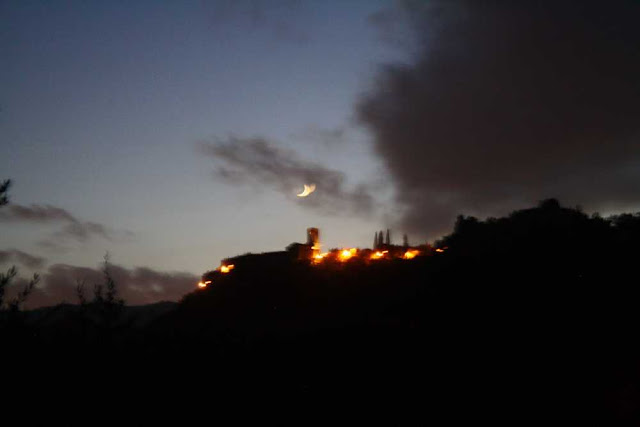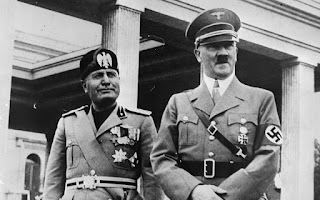We
saw the west side of our house for the first time Friday. Really. We
bought the house two years ago, we’ve lived in it for eight months,
and until now, we never saw the west side. We also never knew that
our kitchen sink drains directly into the downspouts straight down
into someone’s garden—the garden that now hosts Montecarlo’s
biggest celebrations, such as the annual wine festival and the
haunted house for Halloween.
These
are things that sometimes happen when you have a house that was built
in the 14th century.
The
east side of our house fronts on via Roma, the city’s lively main
street. We can walk outside and within a minute we can be sipping an
espresso or ciocolatta calda, dining at Italy’s finest trattorias,
restaurants or pizzerias, savoring gelato, sampling wine and
stuzzichini (appetizers) or shopping for groceries, shoes or fine
Italian clothing. It can be a little loud outside our windows during
a festa, but it’s a happy noise.
The
west side is a totally different world. From our terrazza, we look
over a renaissance-era brick city wall and see the plain of
Lucca—groves of grapes, olive trees, rolling hills, the jagged
Apuane Alps, the mountains that separate Lucca from Pisa. We can see
Lucca in the distance, and the beginning of the Garfagnana valley.
Because of the city wall and our position on a hilltop, no one can
see us because the nearest house with a view over the wall is a mile
away.
Between
us and the wall is a private garden, which, when we bought the house,
actually was a junk yard. It is owned by a wealthy family that is
slowly renovating a huge house that borders on the garden, possibly
to make a hotel—we don’t really know. Juri, our downstairs
neighbor, said the work has been going on for years. Two years ago,
the garden contained piles of bricks, scrap metal and wood and
trashed appliances—not a pretty sight, but then we could just raise
our heads and look over it all if we wanted. And there were periodic
signs of construction on the house and a gradual rearranging and
removal of the junk.
We
came back this fall to find every scrap of rubble removed and the
entire area leveled. A dead tree in the middle had disappeared and
gravel had taken the place of the patchy, scrubby weeds. It’s not
exactly a garden yet, but it’s definitely a neat and tidy
courtyard, It has large scenic photos on the walls of some of the
area’s best vineyards, and we were told that it had been opened to
help host Montecarlo’s 50th annual wine festival in September.
In
the last few days, we’ve seen workers bringing in the metal
framework for the house of horror for Montecharloween, and that’s
how we finally got a view of the west side of our house. We walked by
and saw that the entryway open for the workers, and we went inside
with them. We were pleased to see that our house stood out among the
half dozen others adjoining the garden, because we had collaborated
with Juri’s family to paint both the east and west sides a cheery
bright yellow. We enjoy the fresh look of the east side each time we
approach from the street, and it was nice to get a few minutes of
pleasure and pride by looking at the west side.
The
enjoyment was tempered, however, by the discovery the previous day
that our sink—including our dishwasher—was draining directly into
the garden. Juri had come up to ask us not to use the little sink
outside on our terrazza to wash dishes, because it drained into the
garden right outside the ground floor of our shared house. We were
confused, because we never use that sink. We knew it drained directly
into the gutters. Why would he be telling us not to use something we
already didn’t use? And then it dawned on me. What if the kitchen
sink did the same thing? It only took a moment for all of us to
discover, with horror, that it did.
‟How
long has it been doing that?” Lucy asked. ‟Always,” Juri said.
‟We just didn’t know it, because the garden has been overgrown
for years. Now I put a sidewalk outside the house, and the garden
has been all cleaned up.”
Fortunately,
the soil is fairly absorbent, and the water drains straight across
Juri’s sidewalk before forming a small puddle that dissipates
fairly quickly—but I see a few grains of rice in the puddle,
residue from our dishes. Now I’m thankful that we weren’t here
for the wine festival and that we’ll be gone before Halloween.
Imagine what a brutta figura this would have made if our
kitchen scraps had coming pouring out among a crowd of celebrating
tourists and city officials.
Juri
will have his idraulico—plumber—see what needs to be done
to join the kitchen drain with the bathroom drain (which, we are
certain, properly flows into the sanitary sewer system), and it will
be fixed by time we come back in the winter. The next time we’re in
Montecarlo and the garden is opened for a festa, we’ll be able to
enjoy the event and the view of our house proudly.









































